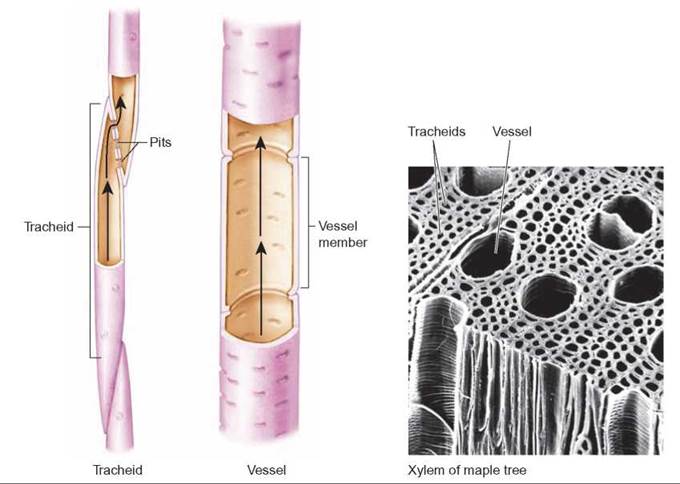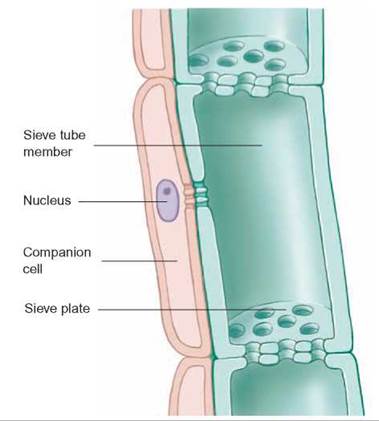CONCEPTS IN BIOLOGY
PART V. THE ORIGIN AND CLASSIFICATION OF LIFE
22. The Plants Kingdom
22.5. The Significance of Vascular Tissue
A major step in the evolution of plants was the development of vascular tissue. Plants like ferns, pines, flowering plants, and many others have vascular tissue. Vascular tissue consists of tube-like cells that allow plants to efficiently transport water and nutrients about the plant. The presence of vascular tissue is associated with the development of roots, leaves, and stems. Roots are underground structures that anchor the plant and absorb water and minerals. Leaves are structures specialized for carrying out the process of photosynthesis. Stems are structures that connect the roots with the leaves and position the leaves so that they receive sunlight.
There are two kinds of vascular tissue: xylem and phloem. Xylem is involved in the transport of water and minerals. The primary direction of flow is from the roots to the leaves. Xylem consists of a series of dead, hollow cells arranged end to end to form a tube. The walls of these “cells” are strengthened with extra deposits of cellulose and a complex organic material called lignin. There are two kinds of xylem cells: vessel elements and tracheids. Vessel elements are essentially dead, hollow cells, up to 0.7 mm in diameter, in which the endwalls are missing. Thus, vessel elements form long tubes similar to a series of pieces of pipe hooked together. Tracheids are smaller in diameter and consist of cells with overlapping, tapered ends. Holes in the walls allow water and minerals to move from one tracheid to the next (figure 22.6).

FIGURE 22.6. Xylem
Xylem consists of hollow, thick-walled cells. Vessel elements are connected end to end and have no endwalls. Tracheids have overlapping portions and pores that allow water to flow from one tracheid to the next.
Phloem carries the organic molecules (primarily sugars and amino acids) produced in the leaves to other parts of the plant where growth or storage takes place. Growth occurs at the tips of roots and stems and in the production of reproductive structures (cones, flowers, fruits). The roots are typically the place where food is stored, but some plants store food in their stems. The phloem consists of two kinds of cells: sieve tube elements and companion cells. The sieve tube elements lack a nucleus and most organelles but retain a modified granular cytoplasm with strands that extend toward the ends of the cell. In addition, the sieve tube elements have holes in the endwalls that allow the flow of water and dissolved nutrients. The companion cells have direct connections to the sieve tube elements and assist in the movement of sugars and amino acids by active transport from cells in the leaves into the sieve tube elements (figure 22.7).

FIGURE 22.7. Phloem
Phloem consists of cells called sieve tube elements (member) and companion cells. The endwalls of the sieve tube elements have holes that allow the movement of materials from one cell to the next. The cells lack a nucleus but have a form of cytoplasm. Companion cells have nuclei and help sieve tube elements transport materials.
To be well adapted to a dry environment, plants need a waterproof layer on their surface in addition to vascular tissue. This layer reduces the amount of water they lose, and the presence of vascular tissue allows for the easy replacement of the water that is lost. Because vascular tissue allows for the more efficient transport of materials throughout the plant, it allows for an increase in plant size. Although not all vascular plants are large, many are able to become large, because vascular tissue allows them to transport water and nutrients efficiently (Outlooks 22.1).
OUTLOOKS 22.1
Plant Terminology
There are several sets of terminology used to discuss plants that describe their nature but do not have any relationship to their taxonomy or phylogeny.
Herbaceous and woody
Herbaceous plants have few cells with thick cell walls and, thus, are generally small and easily damaged. Mosses, grasses, and many garden plants are herbaceous. Woody plants have a great deal of tissue with thick cell walls. The xylem and associated cells are important in strengthening woody plants. There are ferns, gymnosperms, and angiosperms that are woody.
Annual and perennial
Annual plants live one year. They germinate from seeds, grow, produce flowers and seeds, and die within 1 year. The seeds produced germinate the following year and the cycle continues. Most annual plants are angiosperms (flowering plants).
Perennial plants live many years. Most kinds of plants are perennials, including mosses, ferns, horsetails, pines, and most flowering plants. Many perennial plants are woody, such as various kinds of trees. Other perennial plants produce aboveground parts that die back at the end of a growing season. The plant regrows above-ground parts from the roots each year, as do tulips, daffodils, rhubarb, and ferns.
Trees, Shrubs, and Herbs
A tree is a large, woody plant that usually has a single main stem with branches. There are tree ferns, most gymnosperms are trees, and many flowering plants are trees. A shrub is a perennial woody plant that generally has several main stems and is relatively short. Herbs are generally small, herbaceous (nonwoody) plants. The word herb is also used to indicate plants that have specific food, flavoring, or medicinal value.
22.5. CONCEPT REVIEW
10. What are the two kinds of vascular tissue, and what do they do?